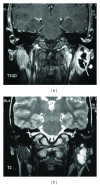Duplication of the external auditory canal: two cases and a review of the literature
- PMID: 23213587
- PMCID: PMC3507044
- DOI: 10.1155/2012/924571
Duplication of the external auditory canal: two cases and a review of the literature
Abstract
The objective of the present paper is to describe the clinical presentation, diagnostic process, surgical treatment, and outcome of 2 patients with first branchial cleft anomaly. The first case was an 8-year-old girl presented with an elastic lesion located in the left infra-auricular area, in close relation with the lobule, duplicating the external auditory canal. The magnetic resonance imaging revealed a lesion, appearing as a rather well-circumscribed mass within the left parotid gland and duplicating the ear canal. A superficial parotidectomy was subsequently performed, with total excision of the cyst. The second patient was a 15-year-old girl presented with a congenital fistula of the right lateral neck. At superficial parotidectomy, a total excision of the fistula was performed. During the operation the tract was recorded to lay between the branches of the facial nerve, extending with a blind ending canal parallel to the external acoustic meatus. Conclusively, first branchial cleft anomalies are rare malformations with cervical, parotid, or auricular clinical manifestations. Diagnosis of first branchial cleft lesions is achieved mainly through careful physical examination. Complete surgical excision with wide exposure of the lesion is essential in order to achieve permanent cure and avoid recurrence.
Figures






Similar articles
-
[Classification and surgical strategy of Work Ⅰ congenital first branchial cleft anomaly based on adjacent anatomy].Lin Chuang Er Bi Yan Hou Tou Jing Wai Ke Za Zhi. 2020 Aug;34(8):695-700. doi: 10.13201/j.issn.2096-7993.2020.08.005. Lin Chuang Er Bi Yan Hou Tou Jing Wai Ke Za Zhi. 2020. PMID: 32842200 Free PMC article. Chinese.
-
A Type-II First Branchial Cleft Anomaly Presenting as a Post-Auricular Salivary Fistula: A Rare Presentation.Ann Med Health Sci Res. 2014 Jan;4(1):136-9. doi: 10.4103/2141-9248.126625. Ann Med Health Sci Res. 2014. PMID: 24669347 Free PMC article.
-
Atypical first branchial cleft fistula: A case report.Int J Surg Case Rep. 2021 Jan;78:159-161. doi: 10.1016/j.ijscr.2020.12.007. Epub 2020 Dec 5. Int J Surg Case Rep. 2021. PMID: 33352445 Free PMC article.
-
Clinical Manifestations, Diagnosis, and Management of First Branchial Cleft Fistula/Sinus: A Case Series and Literature Review.J Oral Maxillofac Surg. 2020 May;78(5):749-761. doi: 10.1016/j.joms.2019.12.017. Epub 2020 Jan 7. J Oral Maxillofac Surg. 2020. PMID: 32008991 Review.
-
First branchial arch abnormality: diagnostic dilemma and excision with facial nerve preservation.J Laryngol Otol. 2012 Sep;126(9):918-22. doi: 10.1017/S0022215112001508. Epub 2012 Jul 12. J Laryngol Otol. 2012. PMID: 22784993 Review.
Cited by
-
A Rare Case of Parotid Swelling Presenting as Branchial Cleft Cyst.Indian J Otolaryngol Head Neck Surg. 2022 Dec;74(Suppl 3):5747-5752. doi: 10.1007/s12070-020-02353-3. Epub 2021 Jan 27. Indian J Otolaryngol Head Neck Surg. 2022. PMID: 36742474 Free PMC article.
-
A Case of First Branchial Cleft Fistula Presenting with an External Opening on the Root of the Helical Crus.Case Rep Med. 2018 Jan 30;2018:4215802. doi: 10.1155/2018/4215802. eCollection 2018. Case Rep Med. 2018. PMID: 29560006 Free PMC article.
-
First branchial cleft sinus with duplicate external auditory canal: A case report.Clin Case Rep. 2022 Apr 8;10(4):e05496. doi: 10.1002/ccr3.5496. eCollection 2022 Apr. Clin Case Rep. 2022. PMID: 35425605 Free PMC article.
-
Odontogenic Cutaneous Sinus Tract in a 10-Year-Old Girl: A Case Report of a Rare Entity.Cureus. 2023 May 17;15(5):e39156. doi: 10.7759/cureus.39156. eCollection 2023 May. Cureus. 2023. PMID: 37378112 Free PMC article.
-
Surgical Approaches to First Branchial Cleft Anomaly Excision: A Case Series.Case Rep Otolaryngol. 2016;2016:3902974. doi: 10.1155/2016/3902974. Epub 2016 Feb 29. Case Rep Otolaryngol. 2016. PMID: 27034873 Free PMC article.
References
-
- Olsen KD, Maragos NE, Weiland LH. First branchial cleft anomalies. Laryngoscope. 1980;90(3):423–436. - PubMed
-
- D’Souza AR, Uppal HS, De R, Zeitoun H. Updating concepts of first branchial cleft defects: a literature review. International Journal of Pediatric Otorhinolaryngology. 2002;62(2):103–109. - PubMed
-
- Ford GR, Balakrishnan A, Evans JNG, Bailey CM. Branchial cleft and pouch anomalies. Journal of Laryngology and Otology. 1992;106(2):137–143. - PubMed
-
- Mukherji SK, Tart RP, Slattery WH, Stringer SP, Benson MT, Mancuso AA. Evaluation of first branchial anomalies by CT and MR. Journal of Computer Assisted Tomography. 1993;17(4):576–581. - PubMed
-
- Benson MT, Dalen K, Mancuso AA, Kerr HH, Cacciarelli AA, Mafee MF. Congenital anomalies of the branchial apparatus: embryology and pathologic anatomy. Radiographics. 1992;12(5):943–960. - PubMed
LinkOut - more resources
Full Text Sources

